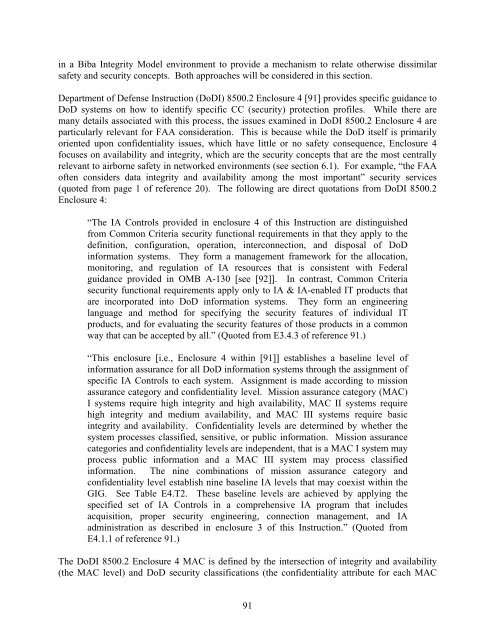Local Area Networks (LANs) in Aircraft - FTP Directory Listing - FAA
Local Area Networks (LANs) in Aircraft - FTP Directory Listing - FAA
Local Area Networks (LANs) in Aircraft - FTP Directory Listing - FAA
Create successful ePaper yourself
Turn your PDF publications into a flip-book with our unique Google optimized e-Paper software.
<strong>in</strong> a Biba Integrity Model environment to provide a mechanism to relate otherwise dissimilar<br />
safety and security concepts. Both approaches will be considered <strong>in</strong> this section.<br />
Department of Defense Instruction (DoDI) 8500.2 Enclosure 4 [91] provides specific guidance to<br />
DoD systems on how to identify specific CC (security) protection profiles. While there are<br />
many details associated with this process, the issues exam<strong>in</strong>ed <strong>in</strong> DoDI 8500.2 Enclosure 4 are<br />
particularly relevant for <strong>FAA</strong> consideration. This is because while the DoD itself is primarily<br />
oriented upon confidentiality issues, which have little or no safety consequence, Enclosure 4<br />
focuses on availability and <strong>in</strong>tegrity, which are the security concepts that are the most centrally<br />
relevant to airborne safety <strong>in</strong> networked environments (see section 6.1). For example, “the <strong>FAA</strong><br />
often considers data <strong>in</strong>tegrity and availability among the most important” security services<br />
(quoted from page 1 of reference 20). The follow<strong>in</strong>g are direct quotations from DoDI 8500.2<br />
Enclosure 4:<br />
“The IA Controls provided <strong>in</strong> enclosure 4 of this Instruction are dist<strong>in</strong>guished<br />
from Common Criteria security functional requirements <strong>in</strong> that they apply to the<br />
def<strong>in</strong>ition, configuration, operation, <strong>in</strong>terconnection, and disposal of DoD<br />
<strong>in</strong>formation systems. They form a management framework for the allocation,<br />
monitor<strong>in</strong>g, and regulation of IA resources that is consistent with Federal<br />
guidance provided <strong>in</strong> OMB A-130 [see [92]]. In contrast, Common Criteria<br />
security functional requirements apply only to IA & IA-enabled IT products that<br />
are <strong>in</strong>corporated <strong>in</strong>to DoD <strong>in</strong>formation systems. They form an eng<strong>in</strong>eer<strong>in</strong>g<br />
language and method for specify<strong>in</strong>g the security features of <strong>in</strong>dividual IT<br />
products, and for evaluat<strong>in</strong>g the security features of those products <strong>in</strong> a common<br />
way that can be accepted by all.” (Quoted from E3.4.3 of reference 91.)<br />
“This enclosure [i.e., Enclosure 4 with<strong>in</strong> [91]] establishes a basel<strong>in</strong>e level of<br />
<strong>in</strong>formation assurance for all DoD <strong>in</strong>formation systems through the assignment of<br />
specific IA Controls to each system. Assignment is made accord<strong>in</strong>g to mission<br />
assurance category and confidentiality level. Mission assurance category (MAC)<br />
I systems require high <strong>in</strong>tegrity and high availability, MAC II systems require<br />
high <strong>in</strong>tegrity and medium availability, and MAC III systems require basic<br />
<strong>in</strong>tegrity and availability. Confidentiality levels are determ<strong>in</strong>ed by whether the<br />
system processes classified, sensitive, or public <strong>in</strong>formation. Mission assurance<br />
categories and confidentiality levels are <strong>in</strong>dependent, that is a MAC I system may<br />
process public <strong>in</strong>formation and a MAC III system may process classified<br />
<strong>in</strong>formation. The n<strong>in</strong>e comb<strong>in</strong>ations of mission assurance category and<br />
confidentiality level establish n<strong>in</strong>e basel<strong>in</strong>e IA levels that may coexist with<strong>in</strong> the<br />
GIG. See Table E4.T2. These basel<strong>in</strong>e levels are achieved by apply<strong>in</strong>g the<br />
specified set of IA Controls <strong>in</strong> a comprehensive IA program that <strong>in</strong>cludes<br />
acquisition, proper security eng<strong>in</strong>eer<strong>in</strong>g, connection management, and IA<br />
adm<strong>in</strong>istration as described <strong>in</strong> enclosure 3 of this Instruction.” (Quoted from<br />
E4.1.1 of reference 91.)<br />
The DoDI 8500.2 Enclosure 4 MAC is def<strong>in</strong>ed by the <strong>in</strong>tersection of <strong>in</strong>tegrity and availability<br />
(the MAC level) and DoD security classifications (the confidentiality attribute for each MAC<br />
91
















